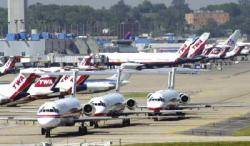Aero-Tips!
A good pilot is always learning -- how many times have you heard
this old standard throughout your flying career? There is no truer
statement in all of flying (well, with the possible exception of
"there are no old, bold pilots.")

Aero-News has called upon the expertise of Thomas P. Turner,
master CFI and all-around-good-guy, to bring our readers -- and us
-- daily tips to improve our skills as aviators. Some of them, you
may have heard before... but for each of us, there will also be
something we might never have considered before, or something that
didn't "stick" the way it should have the first time we memorized
it for the practical test.
Look for our daily Aero-Tips segments, coming each day to you
through the Aero-News Network.
Aero-Tips 09.11.06
 Five years ago this morning I was
pulling out of the company driveway. Just before logging off my
computer I'd seen a CNN "breaking news" banner that a "small plane"
had crashed into one of the World Trade Center Towers.
Five years ago this morning I was
pulling out of the company driveway. Just before logging off my
computer I'd seen a CNN "breaking news" banner that a "small plane"
had crashed into one of the World Trade Center Towers.
We all know the rest of that story.
ANN's editors posed the question of "what's changed" in aviation
as a result of 9/11. I've thought about it quite a bit, and the
answer for me personally is "not much". Most of my cross-country
trips are flown IFR, so airspace isn't much of a challenge. In five
years of actively instructing around the entire United States I've
yet to have to cancel a flight because of Temporary Flight
Restrictions (TFRs). I've always been a proponent of checking
weather and Notices to Aviators (NOTAMs), so a brief TFR check
before each flight is nothing new to me.
Some of my friends have been very affected by 9/11's aftermath,
people who live and fly in the vicinity of Washington, DC. In fact,
I flew (commercially) out of Baltimore/Washington on the night of
9/9/2001 after a weekend of instruction that included "low
approaches" over Andrews Air Force Base, home of Air Force One (we
did have to hold outside the area for a while as the President came
in from somewhere that last peacetime Sunday). Now pilots in the
Baltimore/Washington metroplex have Draconian rules for VFR flight
in the area.
Another demographic that has been hurt noticeably in the wake of
9/11 is the professional flight training sector. Before 9/11 a
large profit center for US flight schools was training foreign
nationals (ironically, most from the Middle East), for whom it was
far cheaper and less restrictive to travel here than to fly at
home. Now that lucrative market is all but gone due to stringent
rules for teaching non-citizens to fly in this country. Some of the
largest American training providers have established satellite
centers overseas to recapture this market.
But for the vast majority of us, I think, not much has changed
as a direct result of 9/11. This is not to say we don't face some
serious obstacles as an industry and an avocation:
-
 The Gulag Aero-pelago. Many
lament the security measures in place at even the smallest airports
since 9/11 that virtually eliminate the "airport kid" hanging
around before finally beginning to learn to fly. Think back,
though, and you'll remember we were talking about this long before
September of 2001. We've put up more fences in the last five years,
but airport managers were chasing onlookers off the ramp before the
War on Terror began-worried then not about an attacker taking to
the skies, but a legal offensive if the slightest little thing went
wrong and the sightseer, or the airport kid's parents, took to the
courts.
The Gulag Aero-pelago. Many
lament the security measures in place at even the smallest airports
since 9/11 that virtually eliminate the "airport kid" hanging
around before finally beginning to learn to fly. Think back,
though, and you'll remember we were talking about this long before
September of 2001. We've put up more fences in the last five years,
but airport managers were chasing onlookers off the ramp before the
War on Terror began-worried then not about an attacker taking to
the skies, but a legal offensive if the slightest little thing went
wrong and the sightseer, or the airport kid's parents, took to the
courts.
- The cost. Fuel prices are a major issue for
pilots today, but the very high cost of flying was in the news long
before 9/11. Remember the Recreational Pilot certificate in the
1980s, and the Primary Aircraft category in the early 1990s? These
were measures pushed hard to approval by the AOPA, EAA and others
to avert the "looming pilot crisis" attributed to flying's great
expense decades before wars (and natural disasters) kicked fuel
prices higher this side of that September.
- Insurance. Fuel notwithstanding, the cost, and
the very availability, of insurance is a big deterrent to personal
flight. This, too, predates 9/11-I'm guilty of writing articles
with titles like "The Insurance Crisis", "Strategies for Lower
Aircraft Insurance Premiums" and "The Airplane Owner's Glass
Ceiling" in the 1990s, showing that 9/11 had little to impact in
this area. Any improvement in aviation safety has been offset by
the costs of repairing broken airplanes, and staving off passenger
lawsuits-and the safety record is complete unrelated to 9/11.
- Airports. Airport closures have been in the
news since the 1980s. Except perhaps in the immediate Washington DC
area, 9/11 has had no effect on the number of runways
available.
- Airlines. Indirectly private aviation suffers
many of the same fates as the airlines, which were in a financial
tail-spin long before the events of September 11th. The era of big
legacy carriers was already crumbling before airliners morphed from
hijacker's bargaining chips to terrorists' cruise missiles.
Significantly, however, carry-on restrictions and public fears of
commercial air travel following the recently foiled London-based
airline terror threat have increased interest in charter and other
"small airplane" flying, which may indirectly boost the Very Light
Jets vision and help keep municipal airports open.
- Public perception. This, too, has been a major
detriment to personal aviation since longer before 9/11. The
difference now is that the terrorists trained in, and apparently
made at least preliminary plans to use, US-based light aircraft to
carry out their schemes. Despite the wisdom that a light airplane
could not carry out 9/11-style destruction, there are any number of
scenarios where a small airplane (and to the public anything from a
Regional Jet on down is a "small airplane") could be used to incite
terror on a limited scale, if even something akin to the
(non-aviation) DC area sniper a couple years ago. ANN has reported
before that terrorist groups are even acquiring small, unmanned
drones for some purpose, and if a payload-challenged Unmanned
Aerial Vehicle causes concern, a Piper Cherokee could engender
panic (remember James Bond's Goldfinger and the PA28 aerial gas
attack on Fort Knox). One successful small-airplane attack on US
soil would be catastrophic for all personal aviation. Short of
that, however, a pre-9/11 public relations blitz must be sustained
to combat the poor public perception of "little airplanes". This
problem did no begin on September 11th.
Aero-tip of the day: Horrible though they were,
in most cases the events of five years ago today did not
precipitate impediments to most personal aviation. Concentrate on
the basics -- safety, education and mentorship, airport security,
public relations and a good Airport Watch program -- to focus on
the real threats to personal aviation's freedoms.
 ANN's Daily Aero-Linx (04.13.24)
ANN's Daily Aero-Linx (04.13.24) ANN's Daily Aero-Term (04.13.24): Beyond Visual Line Of Sight (BVLOS)
ANN's Daily Aero-Term (04.13.24): Beyond Visual Line Of Sight (BVLOS) Airborne 04.09.24: SnF24!, Piper-DeltaHawk!, Fisher Update, Junkers
Airborne 04.09.24: SnF24!, Piper-DeltaHawk!, Fisher Update, Junkers Aero-News: Quote of the Day (04.14.24)
Aero-News: Quote of the Day (04.14.24) ANN's Daily Aero-Term (04.14.24): Maximum Authorized Altitude
ANN's Daily Aero-Term (04.14.24): Maximum Authorized Altitude





